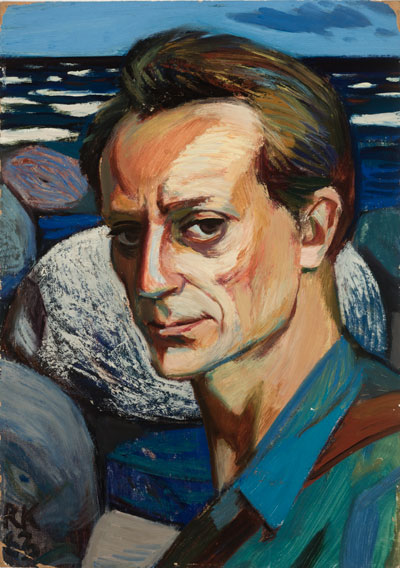
Self portrait. 1963.
Tartu Art Museum.
Raivo Korstnik
Raivo Korstnik (1932–1992) is a valued author in Estonian art world, who during his lifetime, preferred teaching to being active in exhibitions. He received his art education at the State Art Institute of Estonian SSR (1951–1957), where he later worked as a drawing teacher. He also taught at the University of Pedagogy, the Tallinn University of Culture and was connected to the world of cinema in parallel, having worked at the Estonian TV and a cinema studio.
Korstnik was associated with the art innovations of the 1960s and the young emerging avant-garde generation. He also appeared at the 1966 youth exhibition, which is considered one of the most important and first exhibitions focused on modern art in the history of Estonian art. Due to the combined effect of the exhibitions held in Tallinn and Tartu in 1966, the boundary between what was allowed and what was forbidden in the art of that time shifted. The new directions boldly moved away from the official canon of Soviet art and were often based on the methods of surrealism, approaching abstract art.
Korstnik also liked to boldly experiment with different styles. In his work, you can find skillfully painted realistic sea-themed works of the 1960s, industrial landscapes representing the "harsh" style, colorful natural landscapes, cityscapes with cubist shapes, and surreal nude and landscape paintings. Surreal and abstract elements can also be found in sketches with the artist's bold handwriting.
Korstnik helped to organize croquis workshops in the Art House of Tallinn and
hence you can find many nude sketches and drawings in his work. His portraits and nudes often have a strong form, which clearly highlights 3-dimensional form. His scetches have a unique and bold handwriting, where a free and "open" hand is used.
Korstnik armastas käia looduses: talle on omased julge värvikasutusega lausa impressionistlikud maastikud, mägised vaated Armeenia ja Gruusia külakestest, kus ta koos teiste kunstnikega maalilaagrites käis, ning rannamaastikud. Meri oli vist üheks Raivo salajaseks armastuseks, kuna juba 60ndatest on tuntud tema realistlikud meremaalid ja kalurite portreed, mis suures osas olid maalitud Kihnu saarel. Oma hilisemal eluperioodil käis ta koos abikaasa Ene Korstnikuga maalimas mererandasid ning liivaluiteid.
Over the years, Raivo Korstnik's work has been in the permanent exhibition of KUMU (Estonian Art Museum) and in various joint exhibitions. His works can be found in the collections of the Estonian Art Museum, Tartu Art Museum, Tartu University Art Museum and Järvamaa Museum, as well as in several private collections.

Fishermen. 1960. Private collection.

Staircase. 1987. Private collection.
In 2017-2018, a series of exhibitions was dedicated to Korstnik's 85th anniversary, which presented a cross-section of his work from the late 1950s to 1992 and, in addition to the heritage of museums, brought a large number of works kept in private collections to the public for the first time.
Bigger exhibitions in the 21st century:
Fahle Gallery (31.05.2017 – 29.06.2017, “Tagasivaates” / "Looking back");
More info: here.
Pärnu Avangard gallery (24.07.2017 – 06.08.2017, “Tagasivaates: sotsrealismist modernismini” / "Looking back: From social realism to modernism");
More info: here.
Viinistu Art Museum (10.09.2017 – 9.10-2017, “Tagasivaates: Meri ja naised” / "Looking back: The sea and the women");
More info: here.
Café „Fellin” in Viljandi (28.01.2018 – 28.02.2018);
More info: here.
Art House of the island of Ruhnu (30.06.2018 – 15.07.2018. “Tagasivaates: Meri ja naised II” / "Looking back: The sea and the women ll");
More info: here.
Tartu Art House (27.09.2018 – 21.10.2018. “Tagasivaates: Tartu tänavatel” / "Looking back: The streets of Tartu").
More info: here.